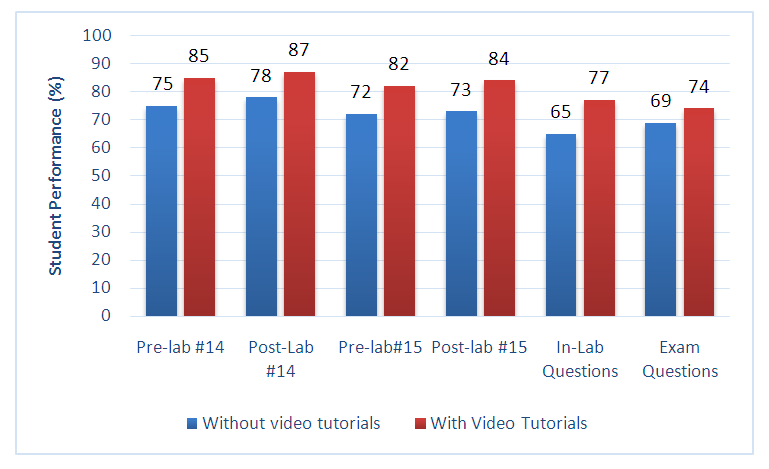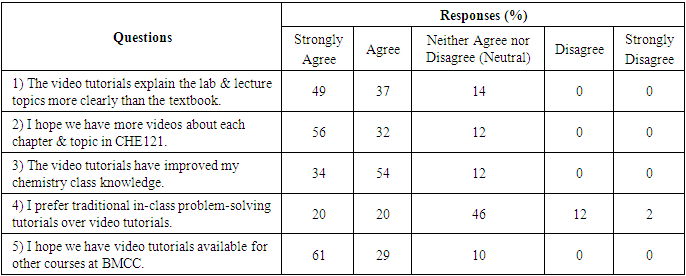-
Paper Information
- Previous Paper
- Paper Submission
-
Journal Information
- About This Journal
- Editorial Board
- Current Issue
- Archive
- Author Guidelines
- Contact Us
American Journal of Chemistry
p-ISSN: 2165-8749 e-ISSN: 2165-8781
2019; 9(6): 165-168
doi:10.5923/j.chemistry.20190906.02

Assessing the Impact of Online Video Tutorials on Student Performance in a Chemistry Course
Ozgur Ecevit, Sumeyra Yumak, Hasan Yumak
Science Department, BMCC, CUNY, New York, NY, USA
Correspondence to: Ozgur Ecevit, Science Department, BMCC, CUNY, New York, NY, USA.
| Email: |  |
Copyright © 2019 The Author(s). Published by Scientific & Academic Publishing.
This work is licensed under the Creative Commons Attribution International License (CC BY).
http://creativecommons.org/licenses/by/4.0/

Educational technology has fostered students' abilities and revolutionized the way they work and think in many areas of higher education. This study investigates the integration of video tutorials as a complement to learning in a nursing chemistry course at a community college setting. Tutorial videos aimed to supplement lectures and labs on the topics of soluble and insoluble salts, solubility rules, solution stoichiometry, and balancing precipitation reactions were designed using video recording tool Loom and were uploaded to the course Web site portal, Blackboard. The results of our study show that using video tutorials, which are a beneficial, adaptable, and affordable tool in teaching nursing chemistry, significantly improved student learning.
Keywords: Video Tutorials, Online Learning, Nursing Chemistry
Cite this paper: Ozgur Ecevit, Sumeyra Yumak, Hasan Yumak, Assessing the Impact of Online Video Tutorials on Student Performance in a Chemistry Course, American Journal of Chemistry, Vol. 9 No. 6, 2019, pp. 165-168. doi: 10.5923/j.chemistry.20190906.02.
1. Introduction
- Generation Z students obtain the majority of their information from the Internet using electronic devices such as smartphones, tablets, computers, etc.and also, the utilization of technology in teaching has become progressively common. Some examples of using technology in college-level courses are online assignments and tutorials. Mastering Chemistry by Pearson, for instance, is one of the most commonly used online teaching/learning platforms. It has been shown that a responsive learning system like Mastering Chemistry improves students’ overall performance in a college-level chemistry course. Students using an online assignment platform are shown to be more motivated compared to students who submit traditional paper homework. Visualization tools such as 3D animations, interactive online 3D models enhance student learning and make the material more attractive for them. Furthermore, online tutoring has been found very effective not only in chemistry or science but also in other courses such as math, writing, language etc. [1,2,3,9,12]Generation Z comprises the majority of the college student population. Although Generation Z and Millenials have some common characteristics, Generation Z is an immensely distinct cohort. Generation Z was born into the age of the Internet, so they have been greatly influenced by technological advancements. They communicate mostly on digital platforms, access to any information extremely quickly. As a result of this fast lifestyle, they can easily get bored, impatient if they don’t receive an immediate response to their questions. It is more than apparent that higher education could not remain untouched by the radical modifications in the current and incoming students ' nature. Educators should conduct important transformations on their teaching methods and how they interact with Generation Z students. Since current college settings have been created for past generations, they have to be redesigned to satisfy the learning styles of Generation Z students. [4] Online video tutorials provide various advantages for students. The most common benefit cited in the literature is flexibility. Students can watch the video tutorials at their own time, as many times as they need to, which is very helpful, especially for independent learners and for students who prefer visual and auditory learning styles. They can pause, rewind, and rewatch the videos at their own pace until they fully grasp the material. An advantage for the instructors is that the students have access to the video tutorials at all times. The instructors can refer the students to the video tutorials when they are asked the same question repeatedly. Another added value is the ability to add closed captioning to video tutorials, which can be of great help for non-native speakers of English and students with hearing impairments. [3,6] Learning preferences of Generation Z, often defined as those born from 1995 to 2010, have been studied by researchers from different disciplines. Based on the outcomes of these studies, instructors have implemented new instructional methods or even modified their curriculum. [5]Borough of Manhattan Community College (BMCC) is an urban community college with approximately 26000 students and more than 10000 students in adult and continuing education programs. According to the BMCC Office of Institutional Effectiveness and Analysis, 72% of BMCC students were born after 1994, and are therefore considered as Generation Z. [11]Community colleges can be described as “institutions of opportunities.” The open-access policy of community colleges attracts students with poor literacy and basic skills. Another selling point of community colleges is their lower tuition fees, which appeal to students, particularly from lower socio-economic backgrounds. They provide opportunities to diverse societal groups with a wide range of needs and responsibilities. In addition to their academic work, many community college students are employed either part-time or full-time to support themselves or their families. Balancing between financial, parental and academic responsibilities is quite a challenging juggling act for community college students. [7,8]Technology has become an indispensable element of everyday life. Almost everyone, particularly younger generations like Generation Z, is connected to the internet 24/7 via smartphones, tablets, etc. However, when students enter the classroom, they are often asked to remove their devices, which unplugs them not only from technology but also from the lecture. Students want to participate in the lecture with the same technology they use in their everyday life. To improve student learning and classroom engagement, instructors need to find innovative ways to implement today’s technology in their classes. [4]
2. Study Design
- The participants of our study were students from the first part of a General, Organic, and Biological (GOB) chemistry course sequence. The course (CHE121), recommended for students intending to transfer to a bachelor’s degree in nursing and allied health science curricula, offers an introduction of the fundamental principles of general, organic, and biological chemistry. CHE121 is one of the biggest courses of the Science Department at BMCC, with an enrollment of approximately 700 students (about 30 sections) each semester. It can be considered as a gateway course into the nursing program because it is usually the first Science course the pre-nursing students take. CHE121 is a 4-credit, 6-hour course that meets twice a week, 3 hours for the lecture, and 3 hours for the lab. The data for this study were collected from 38 sections totaling 796 students between Fall 17 and Summer 19. Half of the student population, 398 students, were marked as the control group to which the videos were not provided.Three types of video tutorials listed below were created on “Solutions,” which is one of the topics students struggle the most. 1. Instructional tutorial videos for the “Lab#15-Soluble and Insoluble Salts” and “Lab#14-Solutions, Electrolytes, and Concentration” labs that walked the students through the entire procedure of the experiments familiarized them with the instruments, equipment, and chemicals, which helped them to feel more confident when performing the experiments.2. Video tutorials for difficult key concepts in solutions chemistry, such as solubility rules, solution stoichiometry, balancing precipitation reactions, etc. The main purpose of these videos was to enhance students’ conceptual understanding.3. Video tutorials to improve students’ problem-solving skills. All video tutorials were created using Microsoft One Note on a Lenovo X201 Tablet PC. Instructional tutorial videos for the labs were recorded with an iPhone 7 plus and edited with the video editing app Splice. Audio and video of the computer screen were captured and edited by the video recording tool Loom. Power DeWise Lavelier microphone was used to ensure high-quality audio. The screen capturing app Loom allows you to share the videos instantly via their platform, so there is no need to download the videos and upload them to any other website. The links to the video tutorials were posted on the Blackboard and made available to students. When creating instructional videos, educators must consider the characteristics of the target viewers. One of the main features of Gen-Z students, limited attention span, is also valid with their video watching habits. Studies have shown a decreased engagement if tutorials are longer than 6 minutes. The videos were therefore kept short, max 12 min long, to keep students engaged. An example of a video tutorial can be watched at the following link: https://www.loom.com/share/folder/5b16002fdbdc40c184c02f87021cb536.In addition, a questionnaire was developed to gather students’ feedback and perception on online video tutorials. The feedback and comments collected from 398 students who had access to the video tutorials were then used to fine-tune the video tutorials.
3. Results
- The effectiveness of the video tutorials was assessed by measuring student performance in the following four categories: pre-lab questions, post-lab questions, in-lab questions, and exam questions. Students’ grades who watched the video tutorials were compared against the control group of students to which the videos were not provided. All questions except the in-lab questions were multiple-choice questions. For in-lab questions, students had to show their work in their report sheet as they performed the lab to get full credit. The grades of students in the control group ranged between 65-78% in these four assignment categories. Our data show that students who watched the video tutorials performed significantly higher in all assignment categories. For example, students’ prelab, post-lab and exam grades improved from 75% to 85%, 78% to 87% and 69% to 74%, respectively. The highest grade improvement (12%) was observed in the in-lab questions category (Figure 1).
 | Figure 1. Comparison of student performance with and without video tutorials |
|
4. Discussion
- The results from this study indicate that online video tutoring, which is a student-controlled, need-based, and task-oriented learning tool, seems to have a positive effect on students’ success in the nursing chemistry class. Because of the aforementioned positive effect of this approach, 88% of students answered agree or strongly agree to survey question 3 (Table 1) that the video tutorials have improved their chemistry class knowledge. The overwhelming majority of the students, 90%, stated that they would like to have video tutorials available for other courses at BMCC (Table 1-question 5). Some instructors may find the process of producing video tutorials intimidating. It requires some effort, like any other work, but it is not as much time-consuming as it used to be in the past. Thanks to today’s advanced technology, the entire process of creating a 10-min long video tutorial, which includes recording, editing and posting online, takes no longer than 30 minutes. Since the video tutorials are not specific to a particular section of a course-they are course-specific-they can be used for other sections of the same course. To increase student success, BMCC offers free face to face and e-tutoring for students. It has been shown that, however, students have a tendency to work individually, at home, as compared to tutoring centers on campus. [10] This may be particularly the case for students, especially for those who have job or family responsibilities and live in traffic dense, urban areas. By using online video tutoring, in which students can pause, rewind, and rewatch the videos at their own pace until they fully comprehend the material, students have more flexibility in terms of time and place of study. Thus, video tutorials may serve as a vital tool to increase students’ success and supplement the learning experience.
 Abstract
Abstract Reference
Reference Full-Text PDF
Full-Text PDF Full-text HTML
Full-text HTML